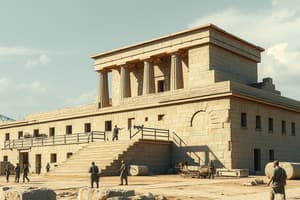Podcast
Questions and Answers
Which characteristic was NOT a common development among ancient civilizations?
Which characteristic was NOT a common development among ancient civilizations?
- Development of agriculture for food production.
- Establishment of complex writing systems for record-keeping.
- Implementation of democratic governance structures in all societies. (correct)
- Construction of monumental architecture for religious or political purposes.
What distinguishes the role of 'intellectuals' from that of 'political leaders' in shaping historical events?
What distinguishes the role of 'intellectuals' from that of 'political leaders' in shaping historical events?
- Political leaders directly influence policy and governance, while intellectuals contribute to the development of ideas and knowledge. (correct)
- There is no distinction; the terms are interchangeable when describing figures who influenced historical change.
- Intellectuals primarily focus on military strategy, whereas political leaders are concerned with long-term social reform.
- Political leaders are involved in religious doctrine, while intellectuals are more concerned with immediate economic impacts.
How did trade and cultural exchange most significantly impact ancient civilizations?
How did trade and cultural exchange most significantly impact ancient civilizations?
- They primarily resulted in military alliances and unified governance.
- They facilitated the spread of new technologies, ideas, and artistic styles. (correct)
- They led to the standardization of religious beliefs across different civilizations.
- They isolated civilizations, leading to unique and distinct cultural developments.
Which of the following best describes the impact of the Roman Empire on Western civilization?
Which of the following best describes the impact of the Roman Empire on Western civilization?
What is a defining characteristic of social movements?
What is a defining characteristic of social movements?
Which factor most significantly influences the success of a social movement?
Which factor most significantly influences the success of a social movement?
Consider the long-term effects. How did the women's rights movement primarily transform society?
Consider the long-term effects. How did the women's rights movement primarily transform society?
What is the most accurate reason for the decline of many ancient civilizations?
What is the most accurate reason for the decline of many ancient civilizations?
Which of these scenarios exemplifies a cultural transformation?
Which of these scenarios exemplifies a cultural transformation?
What was the most significant contribution of the Scientific Revolution to cultural transformation?
What was the most significant contribution of the Scientific Revolution to cultural transformation?
Why is it important to acknowledge that historical figures are often complex and controversial?
Why is it important to acknowledge that historical figures are often complex and controversial?
How did the Indus Valley Civilization demonstrate advanced urban planning?
How did the Indus Valley Civilization demonstrate advanced urban planning?
Considering the various types, what role do artists play in reflecting the values and beliefs of their societies?
Considering the various types, what role do artists play in reflecting the values and beliefs of their societies?
What is the primary focus of environmental movements?
What is the primary focus of environmental movements?
How does globalization contribute to cultural transformation?
How does globalization contribute to cultural transformation?
Which period of cultural transformation emphasized reason, individualism, and human rights?
Which period of cultural transformation emphasized reason, individualism, and human rights?
How did the Industrial Revolution lead to significant cultural transformation?
How did the Industrial Revolution lead to significant cultural transformation?
Which of the following figures would be best described as an 'activist'?
Which of the following figures would be best described as an 'activist'?
What distinguishes Mesopotamia from other ancient civilizations?
What distinguishes Mesopotamia from other ancient civilizations?
What is a key difference between labor movements and civil rights movements?
What is a key difference between labor movements and civil rights movements?
Flashcards
What is History?
What is History?
The study of past events, people, and societies.
What are Ancient Civilizations?
What are Ancient Civilizations?
Civilizations that emerged independently in various parts of the world.
What is Mesopotamia?
What is Mesopotamia?
Located in modern-day Iraq; known as the cradle of civilization.
What is Ancient Egypt?
What is Ancient Egypt?
Signup and view all the flashcards
What is the Indus Valley Civilization?
What is the Indus Valley Civilization?
Signup and view all the flashcards
What is Ancient Greece?
What is Ancient Greece?
Signup and view all the flashcards
What is the Roman Empire?
What is the Roman Empire?
Signup and view all the flashcards
Who are Historical Figures?
Who are Historical Figures?
Signup and view all the flashcards
What are Social Movements?
What are Social Movements?
Signup and view all the flashcards
What are Civil Rights Movements?
What are Civil Rights Movements?
Signup and view all the flashcards
What are Labor Movements?
What are Labor Movements?
Signup and view all the flashcards
What are Women's Rights Movements?
What are Women's Rights Movements?
Signup and view all the flashcards
What are Environmental Movements?
What are Environmental Movements?
Signup and view all the flashcards
What are Anti-War Movements?
What are Anti-War Movements?
Signup and view all the flashcards
What are Cultural Transformations?
What are Cultural Transformations?
Signup and view all the flashcards
What was the Renaissance?
What was the Renaissance?
Signup and view all the flashcards
What was the Scientific Revolution?
What was the Scientific Revolution?
Signup and view all the flashcards
What was the Enlightenment?
What was the Enlightenment?
Signup and view all the flashcards
What was the Industrial Revolution?
What was the Industrial Revolution?
Signup and view all the flashcards
What is Globalization?
What is Globalization?
Signup and view all the flashcards
Study Notes
- History encompasses the study of past events, people, and societies
- Ancient civilizations offer insights into the origins of human society and culture
- Historical figures have significantly influenced events and the course of history
- Social movements have propelled societal change and challenged existing power structures
- Cultural transformations signify shifts in societal values, beliefs, and practices
Ancient Civilizations
- Ancient civilizations emerged independently worldwide
- Mesopotamia, in modern-day Iraq, is recognized as the cradle of civilization
- Ancient Egypt prospered along the Nile, leaving behind architectural wonders and a complex religious system
- The Indus Valley Civilization (present-day Pakistan and India) was known for urban planning and sanitation
- Ancient Greece contributed to philosophy, democracy, and the arts
- The Roman Empire dominated the Mediterranean, establishing a legal and political system influencing Western civilization
- The Maya, Aztec, and Inca civilizations developed complex societies in Mesoamerica and South America
- Ancient civilizations developed agriculture, writing systems, and monumental architecture
- Trade and cultural exchange connected various ancient civilizations
- The decline of ancient civilizations often resulted from environmental change, political instability, and external threats
Historical Figures
- Historical figures significantly impacted historical events
- Political leaders (monarchs, presidents, prime ministers) have shaped nations
- Military leaders (generals, admirals) have led armies and navies in wartime
- Religious leaders (prophets, saints, popes) have influenced religious beliefs and practices
- Intellectuals (philosophers, scientists, writers) have contributed to the development of knowledge and ideas
- Artists (painters, sculptors, musicians) have created works reflecting societal values and beliefs
- Activists (civil rights leaders, revolutionaries) have fought for social and political change
- Explorers (navigators, adventurers) have opened new frontiers and expanded global knowledge
- Historical figures are complex and controversial, with positive and negative aspects to their legacies
- Studying historical figures offers insights into past motivations and actions
Social Movements
- Social movements are organized efforts for social or political change
- Social movements arise in response to perceived injustices or inequalities
- Civil rights movements fought for equal rights for marginalized groups
- Labor movements sought improved working conditions and worker rights
- Women's rights movements advocated for gender equality and women's suffrage
- Environmental movements raised awareness and promoted conservation
- Anti-war movements opposed conflicts and promoted peace
- Social movements employ protests, demonstrations, strikes, and civil disobedience
- Ideology, leadership, and social context influence social movements
- The success of social movements depends on public support, political opportunities, and resource mobilization
Cultural Transformations
- Cultural transformations are fundamental changes in societal values, beliefs, and practices
- Technological innovation, economic development, and social movements drive cultural transformations
- The Renaissance in Europe saw renewed interest in classical art and learning
- The Scientific Revolution saw the development of new scientific methods and theories
- The Enlightenment emphasized reason, individualism, and human rights
- The Industrial Revolution saw the rise of factories, urbanization, and mass production
- Globalization leads to increased interconnectedness and cultural exchange
- Cultural transformations can have positive and negative consequences, leading to progress and social disruption
- Studying cultural transformations helps to understand societal change and its drivers
Studying That Suits You
Use AI to generate personalized quizzes and flashcards to suit your learning preferences.




